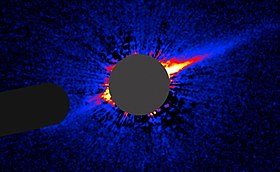
Summary
HD 15115 is a single[10] star in the equatorial constellation of Cetus. It is readily visible in binoculars or a small telescope, but is considered too dim to be seen with the naked eye at an apparent visual magnitude of 6.76.[2] The distance to this object is 160 light years based on parallax,[1] and it is slowly drifting further away at the rate of about 1 km/s.[5] It has been proposed as a member of the Beta Pictoris moving group[11] or the Tucana-Horologium association of co-moving stars; there is some ambiguity as to its true membership.[12]
 Debris disk surrounding young star HD 15115 Credit: NASA | |
| Observation data Epoch J2000 Equinox J2000 | |
|---|---|
| Constellation | Cetus |
| Right ascension | 02h 26m 16.24577s[1] |
| Declination | +06° 17′ 33.1880″[1] |
| Apparent magnitude (V) | 6.76[2] |
| Characteristics | |
| Spectral type | F4IV[3] or F2V[4] |
| U−B color index | −0.03[2] |
| B−V color index | +0.39[2] |
| Astrometry | |
| Radial velocity (Rv) | 0.81±0.12[5] km/s |
| Proper motion (μ) | RA: +88.030[1] mas/yr Dec.: -50.515[1] mas/yr |
| Parallax (π) | 20.4065 ± 0.0418 mas[1] |
| Distance | 159.8 ± 0.3 ly (49.0 ± 0.1 pc) |
| Details | |
| Mass | 1.19[6] M☉ |
| Radius | 1.39±0.06[1] R☉ |
| Luminosity | 3.74±0.01[1] L☉ |
| Surface gravity (log g) | 4.30[6] cgs |
| Temperature | 6,811+148 −152[1] K |
| Metallicity [Fe/H] | 0.96[6] dex |
| Rotational velocity (v sin i) | 89.8[7] km/s |
| Age | 500[8] Myr |
| Other designations | |
| Database references | |
| SIMBAD | data |
This object has a stellar classification of F4IV,[3] suggesting it is an aging subgiant star that has exhausted the supply of hydrogen at its core. MacGregor and associates (2015) instead classify it as a young F-type main-sequence star with a class of F2V.[4] Age estimates give a value of 500[8] million years, while membership in the β Pictoris moving group would indicate an age of around 21±4 million.[4] It has 1.19[6] times the mass of the Sun, 1.39[1] times the Sun's radius, and has a relatively high rate of spin with a projected rotational velocity of 90 km/s.[7] The star is radiating 3.74[1] times the luminosity of the Sun from its photosphere at an effective temperature of 6,811 K.[1] Its metallicity – the abundance of elements other than hydrogen and helium – is nearly the same as in the Sun.[6]
HD 15115 was shown to have an asymmetric debris disk surrounding it, which is being viewed nearly edge-on. The reason for the asymmetry is thought to be either the gravitational pull of a passing star (HIP 12545), an exoplanet, or interaction with the local interstellar medium.[13] A magnitude 11.35 visual companion lies at an angular separation of 12.6″ along a position angle of 195°, as of 2015.[11]
References edit
- ^ a b c d e f g h i j k l Brown, A. G. A.; et al. (Gaia collaboration) (August 2018). "Gaia Data Release 2: Summary of the contents and survey properties". Astronomy & Astrophysics. 616. A1. arXiv:1804.09365. Bibcode:2018A&A...616A...1G. doi:10.1051/0004-6361/201833051. Gaia DR2 record for this source at VizieR.
- ^ a b c d Oja, T. (1983). "UBV photometry of FK4 and FK4 supplement stars". Astronomy and Astrophysics Supplement Series. 52: 131. Bibcode:1983A&AS...52..131O.
- ^ a b Harlan, E. A. (1974). "MK classification for F- and G-type stars. III". Astronomical Journal. 79: 682. Bibcode:1974AJ.....79..682H. doi:10.1086/111597.
- ^ a b c MacGregor, Meredith A.; et al. (March 2015). "Resolved Millimeter Emission from the HD 15115 Debris Disk". The Astrophysical Journal. 801 (1): 8. arXiv:1501.05962. Bibcode:2015ApJ...801...59M. doi:10.1088/0004-637X/801/1/59. S2CID 118407532. 59.
- ^ a b Desidera, S.; et al. (January 2015). "The VLT/NaCo large program to probe the occurrence of exoplanets and brown dwarfs in wide orbits. I. Sample definition and characterization". Astronomy & Astrophysics. 573: 45. arXiv:1405.1559. Bibcode:2015A&A...573A.126D. doi:10.1051/0004-6361/201323168. S2CID 55486025. A126.
- ^ a b c d e Luck, R. Earle (March 2018), "Abundances in the Local Region. III. Southern F, G, and K Dwarfs", The Astronomical Journal, 155 (3): 31, Bibcode:2018AJ....155..111L, doi:10.3847/1538-3881/aaa9b5, S2CID 125765376, 111.
- ^ a b Pribulla, Theodor; et al. (September 2014). "Cerro Armazones spectroscopic survey of F dwarfs". Monthly Notices of the Royal Astronomical Society. 443 (3): 2815–2823. Bibcode:2014MNRAS.443.2815P. doi:10.1093/mnras/stu1333.
- ^ a b Decin, G.; et al. (November 2003), "Age Dependence of the Vega Phenomenon: Observations", The Astrophysical Journal, 598 (1): 636–644, arXiv:astro-ph/0308294, Bibcode:2003ApJ...598..636D, doi:10.1086/378800, S2CID 16751327
- ^ "HD 15115". SIMBAD. Centre de données astronomiques de Strasbourg. Retrieved 2019-11-15.
- ^ Rodriguez, David R.; Zuckerman, B. (February 2012). "Binaries among Debris Disk Stars". The Astrophysical Journal. 745 (2): 13. arXiv:1111.5618. Bibcode:2012ApJ...745..147R. doi:10.1088/0004-637X/745/2/147. S2CID 73681879. 147.
- ^ a b Alonso-Floriano, F. J.; et al. (November 2015). "Reaching the boundary between stellar kinematic groups and very wide binaries. III. Sixteen new stars and eight new wide systems in the β Pictoris moving group". Astronomy & Astrophysics. 583: 24. arXiv:1508.06929. Bibcode:2015A&A...583A..85A. doi:10.1051/0004-6361/201526795. S2CID 3131908. A85.
- ^ Malo, Lison; et al. (January 2013), "Bayesian Analysis to Identify New Star Candidates in Nearby Young Stellar Kinematic Groups", The Astrophysical Journal, 762 (2): 50, arXiv:1209.2077, Bibcode:2013ApJ...762...88M, doi:10.1088/0004-637X/762/2/88, S2CID 118497872, 88.
- ^ Debes, J. H.; et al. (2009). "Interstellar Medium Sculpting of the Hd 32297 Debris Disk". The Astrophysical Journal. 702 (1): 318–326. arXiv:0908.4368. Bibcode:2009ApJ...702..318D. doi:10.1088/0004-637X/702/1/318. S2CID 15303091.


